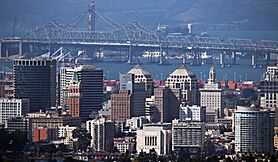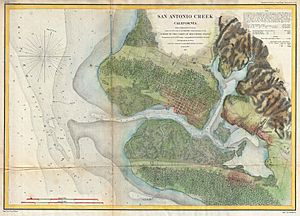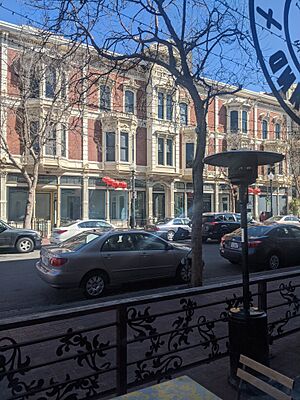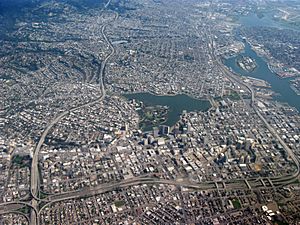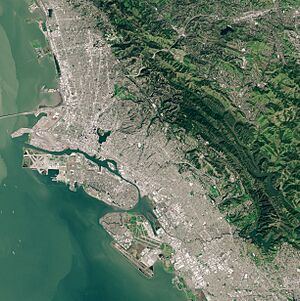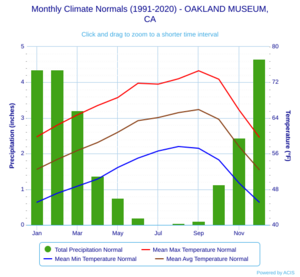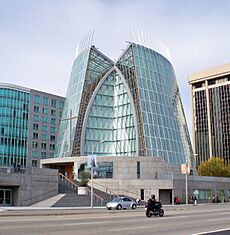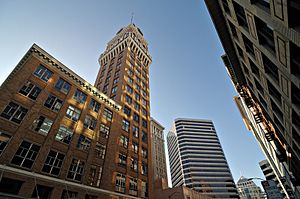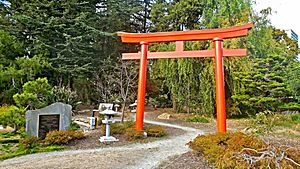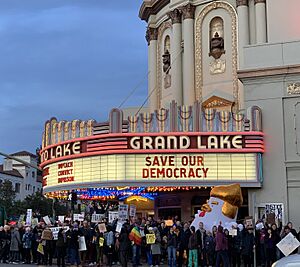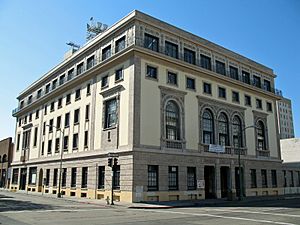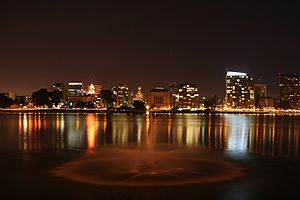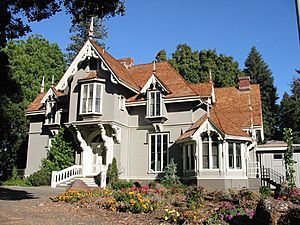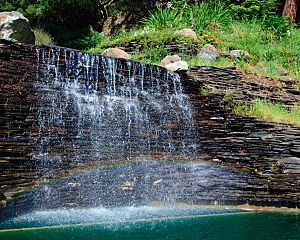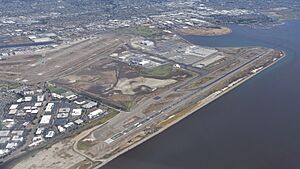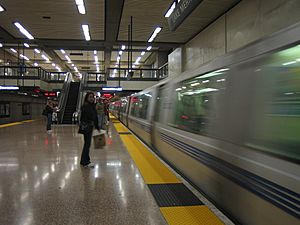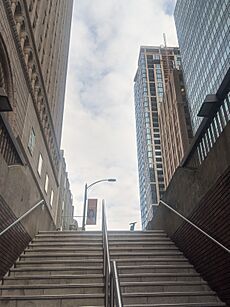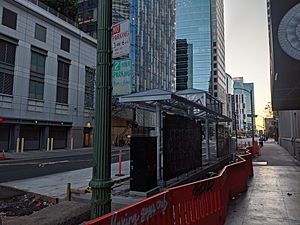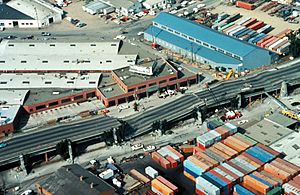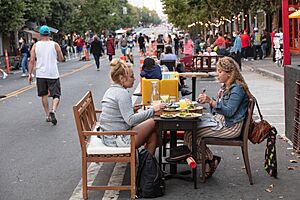Oakland, California facts for kids
Quick facts for kids
Oakland
|
|||||
|---|---|---|---|---|---|
|
Skyline of Downtown Oakland, with the San Francisco Bay in the background
Davidson Courthouse
Eastern span of the Bay Bridge
|
|||||
|
|||||
| Nickname(s):
"Oaktown", "The Town"
|
|||||
| Motto(s):
"Love life"
|
|||||

Location in Alameda County and the U.S. state of California
|
|||||
| Country | United States | ||||
| State | California | ||||
| County | Alameda | ||||
| Incorporated | May 4, 1852 | ||||
| Named for | The large oak forest that originally covered the area | ||||
| Government | |||||
| • Type | Strong mayor | ||||
| • Body | Oakland City Council | ||||
| Area | |||||
| • Total | 78.03 sq mi (202.10 km2) | ||||
| • Land | 55.93 sq mi (144.86 km2) | ||||
| • Water | 22.10 sq mi (57.24 km2) | ||||
| Elevation | 43 ft (13 m) | ||||
| Population
(2020)
|
|||||
| • Total | 440,646 | ||||
| • Rank | 1st in Alameda County 8th in California 45th in the United States |
||||
| • Density | 7,878.53/sq mi (3,041.87/km2) | ||||
| Demonym(s) | Oaklander | ||||
| Time zone | UTC−08:00 (PST) | ||||
| • Summer (DST) | UTC−07:00 (PDT) | ||||
| ZIP Codes |
94601–94615, 94617-94624, 94649, 94659–94662, 94666
|
||||
| Area codes | 510/341 | ||||
| FIPS code | 06-53000 | ||||
| GNIS feature IDs | 277566, 2411292 | ||||
| Website | |||||
Oakland is a big city in California, located in the San Francisco Bay Area. It's the main city in Alameda County and had about 440,646 people in 2020. Oakland is a very important West Coast port. It's the busiest port in Northern California.
The city was officially started on May 4, 1852. This happened because many people moved to California during the California gold rush. Oakland got its name from the many oak trees that used to grow there.
In the 1850s, the first campus of the University of California began in Oakland. Also, in 1869, Oakland became the western end of the Transcontinental Railroad. The next year, Lake Merritt became the first official wildlife refuge in the United States. It is now a National Historic Landmark. After the big 1906 San Francisco earthquake, many people moved to Oakland from San Francisco. This helped Oakland grow even more.
Contents
History of Oakland
Who Lived in Oakland First?
The first people known to live in the Oakland area were the Huchiun natives. They lived there for thousands of years. These people were part of a larger group called the Ohlone. They mostly lived around Lake Merritt and Temescal Creek.
Spanish and Mexican Times

In 1772, Spanish settlers took over the area that is now Oakland. In the early 1800s, the Spanish king gave this land to Luis María Peralta. It was called Rancho San Antonio. When Mexico became independent, they confirmed this land grant.
After Peralta died in 1842, he split his land among his four sons. Most of Oakland went to Antonio Maria and Vicente. This part of the land was called Encinar, which means "oak grove" in Spanish. This is why the city is named Oakland.
After California became part of the United States, the Peralta family faced problems. They lost their land because new settlers moved in. An attorney named Horace Carpentier tricked Vicente Peralta into signing a paper that made him lose his land. The Peralta family had to leave their home.
How Oakland Began as a City
In 1851, three men, Horace Carpentier, Edson Adams, and Andrew Moon, started building what is now downtown Oakland. In 1852, the state officially made Oakland a town. At that time, Oakland had only about 75 to 100 people. It had two hotels, a dock, and two warehouses.
Two years later, on March 25, 1854, Oakland became the City of Oakland. Horace Carpentier was chosen as the first mayor. In 1853, a school was started in Oakland that later became the University of California. The university moved to Berkeley in the 1870s.
During the 1850s, Oakland grew quickly. Land in San Francisco was becoming too expensive. Many people from China also moved to Oakland. They were often hired to work on railroads. However, they faced unfair treatment and discrimination.
The city grew even more with the railroads. In 1868, the Central Pacific built the Oakland Long Wharf. This was at Oakland Point, where the Port of Oakland is today.
In the late 1800s, many horsecar and cable car lines were built in Oakland. The first electric streetcar started running in 1891. These streetcar companies later joined together to form the Key System. This system was the start of today's AC Transit bus system.
Oakland from 1900 to 1950s

Oakland was affected by a plague from 1900 to 1904. Ships arriving at Oakland ports were checked for infected rats. Health officials worked to control the disease. In 1919, a small outbreak of Pneumonic plague killed about a dozen people.
How Oakland Grew
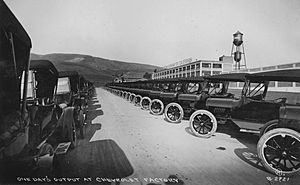
When Oakland became a city in 1852, it was a small area. Over time, it added more land from nearby farms and towns. In 1902, a shipping channel was dug. This made the nearby town of Alameda into an island.
In 1906, the city's population doubled. This happened after the 1906 San Francisco earthquake and fire. Many people lost their homes in San Francisco and moved to Oakland.
In 1917, General Motors opened a car factory in East Oakland. It was called Oakland Assembly. This factory made Chevrolet cars and GMC trucks. By 1929, Oakland was known as the "Detroit of the West" because of its many car factories.
Oakland grew a lot in the 1920s as more factory workers moved in. Many of the large buildings and houses you see in Oakland today were built during this time.
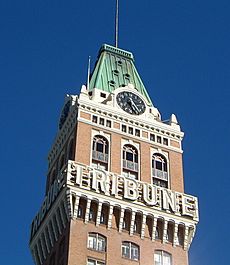
During World War II, the Oakland area had many industries that helped with the war effort. The Moore Dry Dock Company built over 100 ships. Oakland's canning industry was also very important.
Many workers came to Oakland from all over the country. This included people from the South looking for jobs. After the war, many jobs were lost as industries changed. In 1946, Oakland had a big general strike.

In 1946, a company bought most of the Key System streetcar company. Over the next few years, Oakland's electric streetcar system was replaced with cheaper diesel buses. Today, AC Transit runs the bus system.
Oakland from 1960 to 1999
In 1960, the Kaiser Corporation opened its new main office. It was the largest office building west of Chicago at the time. After the war, more people moved to the suburbs. Wealthier residents left Oakland for new homes.
In 1966, only a small number of police officers in Oakland were Black. This caused tension between the Black community and the police. In 1966, Huey Newton and Bobby Seale started the Black Panther Party in Oakland. They worked to help the Black community and protect them from unfair treatment.
By 1980, about 47% of Oakland's population was Black.
A big earthquake, the Loma Prieta earthquake, happened on October 17, 1989. Many buildings in Oakland were damaged. A part of Interstate 880 collapsed, and 42 people died. The San Francisco–Oakland Bay Bridge was also damaged and closed for a month.
On October 20, 1991, a huge firestorm swept through the Berkeley/Oakland hills. Twenty-five people died, and almost 4,000 homes were destroyed. This was one of the worst urban fires in American history.
In the mid-1990s, Oakland's economy started to get better. New types of jobs appeared. The city also worked on big development projects, especially in downtown and at the Port of Oakland.
Oakland in the 21st Century
After 1999, Mayor Jerry Brown supported building more homes downtown. This led to many new apartments and buildings. However, some people worried about rising rents and gentrification. This could force lower-income residents to move out of downtown.
In 2011, protesters started "Occupy Oakland" demonstrations in downtown Oakland. This was to protest various issues.
Between 2000 and 2010, the number of African Americans in Oakland decreased. This was due to rising rents and a housing shortage.
In 2016, a fire at the Ghost Ship warehouse killed 36 people. After this, the city checked other warehouses and living spaces.
In 2019, some homeless mothers moved into an empty house to protest the housing crisis. This event got national attention. The company that owned the house later said they would sell it to a group that helps with affordable housing.
Between 2014 and 2020, Oakland made rules to protect renters. This was to help long-time residents stay in their homes.
Sadly, between 2019 and 2023, Oakland lost three major professional sports teams. This was a first for any American city.
Oakland's Geography
Oakland is located in the eastern part of the San Francisco Bay.
The city covers about 78 square miles (202 square kilometers). About 56 square miles (145 square kilometers) is land, and 22 square miles (57 square kilometers) is water.
Oakland's highest point is near Grizzly Peak Blvd. It is about 1,760 feet (536 meters) above sea level. Oakland has 19 miles (31 kilometers) of shoreline. However, Radio Beach is the only beach in the city.
People in Oakland often talk about "the flatlands" and "the hills." The flatlands are the lower, flatter parts of the city. The hills are the higher areas. The hills used to be much wealthier than the flatlands. About two-thirds of Oakland is in the flat plain of the East Bay. The other third rises into the hills.
The Hayward fault runs right through Oakland. Earthquakes on the nearby San Andreas Fault can cause movement on the Hayward fault. This can lead to smaller, slow movements of the ground.
Oakland's Neighborhoods

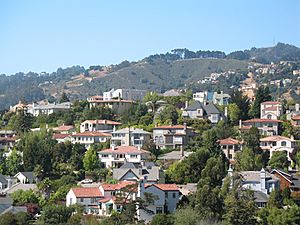
Oakland has more than 50 different neighborhoods. The main parts of the city include downtown Oakland, Lake Merritt, East Oakland, North Oakland, West Oakland, and the Oakland Hills. East Oakland is the largest area. It stretches from Lake Merritt to the San Leandro border. North Oakland is between downtown and Berkeley. West Oakland is between downtown and the Bay. In 2011, Oakland was ranked as one of the most walkable cities in the United States.
Lake Merritt is a special urban lake near downtown. It has a mix of fresh and salt water. It was named the first official wildlife refuge in the United States in 1870. The lake is surrounded by homes and businesses.
The city of Piedmont is a small, independent city. It is completely surrounded by Oakland.
Oakland's Climate
Oakland has a warm-summer Mediterranean climate. This means it has warm, dry summers and cool, wet winters. The city gets about 260 sunny days each year.
Oakland's climate is known for being mild and pleasant. It is warmer than San Francisco but cooler than San Jose. This is because it is on San Francisco Bay. The northern part of the city can get cool fog from the bay. However, the fog often clears by midday, making for sunny afternoons. The hills tend to have more fog than the flatlands.
The highest temperature ever recorded in downtown Oakland was 104°F (40°C) in 1957. The lowest was 24°F (-4°C) in 1949. Sometimes, dry, warm "Diablo" winds blow. These winds can increase the risk of fires, like the big Oakland Hills fire in 1991.
Oakland gets most of its rain between November and April. The wettest year on record was from 1997 to 1998. The driest was from 2020 to 2021.
Plants and Trees in Oakland
The hills get more rain. This helps oak, madrona, pine, and fir trees grow. There are also a few redwood groves in wetter spots. Before the 1800s, some of the tallest redwood trees in California grew in the Oakland Hills. These trees were used by ships to find their way into the Golden Gate. You can still see a very old tree stump that is 30 feet (9 meters) wide near Redwood Regional Park.
Sunny, drier slopes have grass or scattered oak trees and chaparral brush. Many Australian eucalyptus trees have been planted. They grow well because they come from a similar climate.
People and Culture in Oakland
| Historical population | |||
|---|---|---|---|
| Census | Pop. | %± | |
| 1860 | 1,543 | — | |
| 1870 | 10,500 | 580.5% | |
| 1880 | 34,555 | 229.1% | |
| 1890 | 48,682 | 40.9% | |
| 1900 | 66,960 | 37.5% | |
| 1910 | 150,174 | 124.3% | |
| 1920 | 216,261 | 44.0% | |
| 1930 | 284,063 | 31.4% | |
| 1940 | 302,163 | 6.4% | |
| 1950 | 384,575 | 27.3% | |
| 1960 | 367,548 | −4.4% | |
| 1970 | 361,561 | −1.6% | |
| 1980 | 339,337 | −6.1% | |
| 1990 | 372,242 | 9.7% | |
| 2000 | 399,484 | 7.3% | |
| 2010 | 390,724 | −2.2% | |
| 2020 | 440,646 | 12.8% | |
| 2023 (est.) | 436,504 | 11.7% | |
| U.S. Decennial Census | |||
In 2020, Oakland had 440,646 people. The city is very diverse.
Religions in Oakland
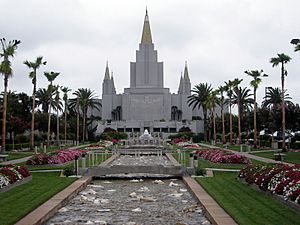
About 35% of people in Oakland belong to a religion. There are 417 different religious groups.
Some major places of worship include:
- 31st Street Islamic Center (Islam)
- Allen Temple Baptist Church (Baptist)
- Ascension Cathedral (Greek Orthodox)
- Beth Jacob Congregation (Jewish)
- Cathedral of Christ the Light (Roman Catholic)
- Oakland California Temple (The Church of Jesus Christ of Latter-day Saints)
Different Backgrounds in Oakland
Oakland is known for being one of the most diverse cities in the U.S. In 2020, the main groups were:
- White: 35.5%
- Black or African American: 23.8%
- Asian: 15.5%
- Hispanic or Latino (any race): 27.0%
The number of white residents decreased a lot from 1940 to 1990. This was partly because people moved to the suburbs. Many African Americans moved to Oakland during and after World War II for jobs. The Black population was highest in 1980, at about 47%.
Recently, Oakland's Black population has decreased. This is because housing prices have gone up. Many Black residents have moved to other parts of the Bay Area or to the Southern United States.
Many immigrants have also settled in Oakland. They often march to support fair laws for immigrants.
Oakland also has a large LGBTQ+ community. In 2000, it had one of the highest numbers of same-sex female couples among large U.S. cities.
Changes in Neighborhoods (Gentrification)
Oakland has seen a lot of gentrification. This means that new, higher-income residents are moving into older, lower-income neighborhoods. This often happens because of high-paying tech jobs. Housing prices go up, and lower-wage residents might have to move out.
For example, in West Oakland, average household income and the number of college graduates have increased. This has changed the community and culture of Oakland. Many working-class residents have moved to suburbs further away.
In 2015, it was found that most low-income households of color were in neighborhoods that were gentrifying or at risk of it. This shows how these changes affect different groups of people.
Oakland's Economy
Oakland is a very important port on the West Coast. It is the fifth busiest port in the United States for cargo. The Port of Oakland handles 99% of all goods shipped in containers through Northern California. This trade is worth $41 billion. Nearly 200,000 jobs in the Oakland area are related to shipping.
The Port of Oakland was a leader in using containerized shipping. This means goods are packed in large containers that can easily be moved between ships, trucks, and trains.
Oakland is also home to several big companies. These include Kaiser Permanente, Clorox, and Dreyer's ice cream. Tech companies like Ask.com and Pandora Radio are also in Oakland. Many new tech and green energy companies have started in downtown Oakland.
In 2013, the San Francisco-Oakland-Hayward area had a gross domestic product (GDP) of $360.4 billion. This ranked it eighth among U.S. metropolitan areas. In 2014, Oakland was one of the best cities to start a career. Many companies from San Francisco are moving to Oakland.
Oakland's population and land values increased in the early 2000s. New housing projects were built. However, in 2023, Oakland became the first American city to lose three major professional sports teams in five years.
Top Employers in Oakland
As of 2024, the biggest employers in Oakland are:
| # | Employer | # of Employees |
|---|---|---|
| 1 | Kaiser Permanente | 11,500+ |
| 2 | County of Alameda | 8,000+ |
| 3 | Oakland Unified School District | 5,500+ |
| 4 | City of Oakland | 4,500+ |
| 5 | State of California | 4,000+ |
| 6 | Bay Area Rapid Transit | 4,000+ |
| 7 | Southwest Airlines | 3,000+ |
| 8 | Alameda Health System | 2,500+ |
| 9 | Children's Hospital Oakland | 2,500+ |
| 10 | Federal Express | 2,000+ |
Tourism in Oakland
In 2013, over 2.5 million people visited Oakland. They spent $1.3 billion, helping the local economy. More and more people are staying in hotels in Oakland.
Oakland has become a popular place to visit. In 2012, The New York Times called Oakland the best North American city to visit. They noted its many restaurants, bars, and music places. Oakland was also ranked high for its entertainment and outdoor activities. It was even called one of "America's Most Exciting Cities."
Arts and Culture in Oakland
Oakland has a lively art scene. It has one of the highest numbers of artists per person in the U.S. In 2013, Oakland was named one of America's top art communities. Areas like Uptown, Chinatown, and Jack London Square were recognized for their art, shops, and restaurants.
You can find art galleries in many parts of Oakland. The city is also famous for its food. It has many different types of restaurants and markets. They often use local ingredients and offer international foods. This shows the many different cultures in Oakland.
Oakland has a rich music history. It was important for blues and jazz music. Today, it's home to musicians from many styles. These include rhythm and blues, gospel, funk, punk, heavy metal, Rap, and hip hop. Famous artists from Oakland include Green Day, Tower of Power, and MC Hammer.
Fun Places to Visit in Oakland
Here are some popular attractions in Oakland:
- African American Museum and Library at Oakland
- Chabot Space and Science Center
- Children's Fairyland
- Chinatown
- Dunsmuir House
- Fox Oakland Theatre, a concert hall
- Jack London Square
- Joaquin Miller Park
- Lake Merritt, the oldest wildlife refuge in North America
- Oakland Museum of California
- Oakland Zoo
- Paramount Theatre
- Redwood Regional Park
- USS Potomac, Franklin D. Roosevelt's presidential yacht
Nightlife and Entertainment
Downtown Oakland has many bars and nightclubs. You can find dance clubs, modern lounges, and jazz bars. The Paramount Theater and Fox Oakland Theatre host many concerts and shows. In 2012, Oakland became known as a "New Sin City" after it made its nightlife rules more relaxed.
The Oakland Art Murmur is a popular event. It happens on the first Friday of every month in the Uptown neighborhood. Thousands of people come to see live performances, food trucks, and over 30 art galleries.
"There is no there there"
Writer Gertrude Stein once wrote about Oakland, "There is no there there." She said this because the neighborhood where she grew up had been torn down. People often misunderstand this quote to mean all of Oakland.
Today, Oakland has tried to show that this is not true. There is a statue downtown called There. In 2005, a sculpture called HERETHERE was put up on the border between Berkeley and Oakland. It spells out "HERE" and "THERE" with large letters.
Sports in Oakland
Oakland used to be home to several major professional sports teams.
The Oakland Athletics baseball team won three World Series championships in the 1970s. They won another in 1989. They played at the Oakland Coliseum. The Athletics plan to move to Las Vegas in the future. This will leave Oakland without a major professional sports team for the first time since 1959.
The Oakland Raiders football team won two Super Bowls while in Oakland. They moved to Las Vegas in 2020.
The Golden State Warriors basketball team won several NBA championships. They moved to San Francisco in 2019.
Newer teams in Oakland include:
- The Oakland Roots SC, a professional soccer team started in 2018. They play at Pioneer Stadium.
- The Oakland Soul SC, a women's professional soccer club that started in 2023. They also play at Laney College.
- The Oakland Spiders, an ultimate team that moved to Oakland in 2022.
- The Oakland Ballers, a baseball team that started in 2023. They play at Raimondi Park.

Some of Oakland's former sports teams include:
- Oakland Oaks (baseball), 1903–1955
- Oakland Seals (hockey), 1967–1976
Parks and Fun in Oakland
Parks in Oakland
Oakland has many parks and recreation centers. They cover a total of about 5,937 acres (2,403 hectares). In 2013, Oakland's park system was ranked 18th best among the 50 largest U.S. cities. It was also ranked fourth for nature lovers.
Some of the city's most famous parks are:
- Bushrod Park
- Joaquin Miller Park
- Joseph Knowland State Arboretum and Park, home to the Oakland Zoo
- Lake Merritt
- Morcom Rose Garden
- Mosswood Park
- Redwood Regional Park
Seven East Bay Regional Parks are also partly or fully in Oakland.
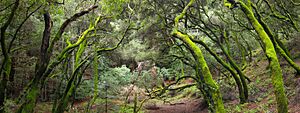
Education in Oakland
Schools for Kids and Teens
The Oakland Unified School District (OUSD) runs most of Oakland's public schools. As of 2015, OUSD had 86 schools and 32 charter schools. It also has adult education programs. There were over 48,000 students in K-12 schools.
OUSD test scores are generally lower than the rest of California. This is partly because many students are learning English. However, some schools perform much better than the city average.
Oakland's three largest public high schools are Oakland High School, Oakland Technical High School, and Skyline High School.
Some charter schools include the Oakland Military Institute and the Oakland School for the Arts.
There are also many private high schools. These include The College Preparatory School and Bishop O'Dowd High School. Catholic schools are run by the Roman Catholic Diocese of Oakland.
School Funding
In 2017, the Oakland Unified School District received money from Pandora and Little Kids Rock. This helped expand music education programs in schools. Teachers got training, and new instruments were provided. This helped over 2,000 students.
Colleges and Universities
Oakland has several colleges and universities:
- Peralta Community College District (includes Laney College and Merritt College)
- California College of the Arts
- Lincoln University
- Mills College
- Samuel Merritt University
Oakland is also home to the main office of the University of California system.
Media in Oakland
Oakland is served by major TV stations from San Francisco and San Jose. KTVU 2, a Fox station, is based in Oakland. Several radio stations are also licensed to Oakland.
The Oakland Tribune newspaper started in 1874. The Tribune Tower is a famous Oakland landmark with a large clock. The clock plays classic melodies at certain times of the day. The newspaper moved its offices in 2007 and stopped publishing in 2011.
The East Bay Express is a free weekly newspaper based in Oakland.
How Oakland Gets Around
Airports and Trains
Oakland residents can use three main airports: Oakland International Airport, San Francisco International Airport, and San Jose International Airport. Oakland International Airport is just 4 miles (6.4 kilometers) south of downtown. It has flights to places all over the world. AC Transit buses and BART's Oakland Airport Connector train connect to the airport.
The city has train service from Amtrak. There are stations near Jack London Square and the RingCentral Coliseum.
In the past, many train companies served Oakland. Passengers would often take ferries from the train stations to San Francisco.
Buses, Bikes, and Scooters
In 2007, about 24% of Oaklanders used public transportation, walked, or used other ways to get to work. About 17% of homes in Oakland did not have a car.
AC Transit provides bus service in Oakland. Many bus lines follow the old routes of the Key System streetcars.
Bay Area Rapid Transit (BART) trains serve Oakland from eight stations. BART's main office is in Oakland.
The Alameda / Oakland Ferry offers ferry service from Jack London Square to Alameda and San Francisco.
Oakland also has many bike racks and bike lanes. The city wants to encourage people to bike instead of drive. In 2011, Oakland was seventh among large U.S. cities for people who biked to work.
Electric Scooters
In 2019, Oakland allowed companies like Bird and Lime to offer shared electric scooters. The city requires these companies to teach users how to ride safely. They also need to make sure scooters are available all over the city.
Bridges, Freeways, and Tunnels
Oakland has several major highways. Traffic from the Bay Bridge splits into three freeways in Oakland. These include Interstate 580, Interstate 880, and Interstate 80.
During the 1989 Loma Prieta earthquake, a part of the Nimitz Freeway collapsed. This killed 42 people. The freeway was later rebuilt in a different area. The Bay Bridge was also damaged but repaired quickly.
Two underwater tunnels, the Webster and Posey Tubes, connect Alameda to downtown Oakland. Several bridges also connect Alameda to East Oakland over the Oakland Estuary.
The Caldecott Tunnel carries Highway 24 through the Berkeley Hills. It connects central Contra Costa County to Oakland.
Oakland Slow Streets Program
In April 2020, Oakland started its Slow Streets Program. This program closed 74 miles (119 kilometers) of streets to through traffic. The goal was to help people walk, bike, and jog safely during the COVID-19 pandemic. It also helped reduce traffic and promote other ways to get around.
At first, the city mostly got feedback from wealthier residents. This made it seem like everyone loved the program. But later, officials realized they needed to hear from all residents, especially those in East Oakland. These communities wanted more safety measures, not just closed streets. The city then added more safety features in important areas like near grocery stores and COVID-19 test sites.
Freight Shipping
The Port of Oakland is the largest seaport on San Francisco Bay. It is one of the three major ports on the West Coast. It was one of the first ports to use containers for shipping. This made it easier to move goods between ships, trucks, and trains.
City Services
The East Bay Municipal Utility District (EBMUD) provides water and sewage treatment. Pacific Gas and Electric Company (PG&E) provides natural gas and electricity. Waste Management, Inc. handles garbage collection.
Oakland is a leader in using electricity from renewable sources.
Healthcare in Oakland
Kaiser Permanente started in Oakland in 1942. It was created to provide healthcare for workers during World War II. Today, it is one of the largest healthcare providers in the world. Its main office is in downtown Oakland.
Alta Bates Summit Medical Center has a large hospital campus in Oakland. Alameda Health System runs five hospitals in Alameda County, including Highland Hospital in Oakland.
Children's Hospital Oakland is the main hospital for kids in the East Bay. It is a top center for treating serious injuries in children. There are also several local health centers in Oakland.
Sister Cities
Oakland has 13 sister cities around the world:
| City | Country | Year of Partnership |
|---|---|---|
| 1962 | ||
| Sekondi-Takoradi | 1975 | |
| 1975 | ||
| Dalian | 1982 | |
| 1999 | ||
| Santiago de Cuba | 2000 | |
| Da Nang | 2005 | |
| Benin City | 2010 | |
| Port-de-Paix | 2011 | |
| Oakleigh | 2020 | |
| Foshan | ||
| Bauchi | 2010 | |
| Ocho Rios | 1986 |
See also
 In Spanish: Oakland (California) para niños
In Spanish: Oakland (California) para niños


